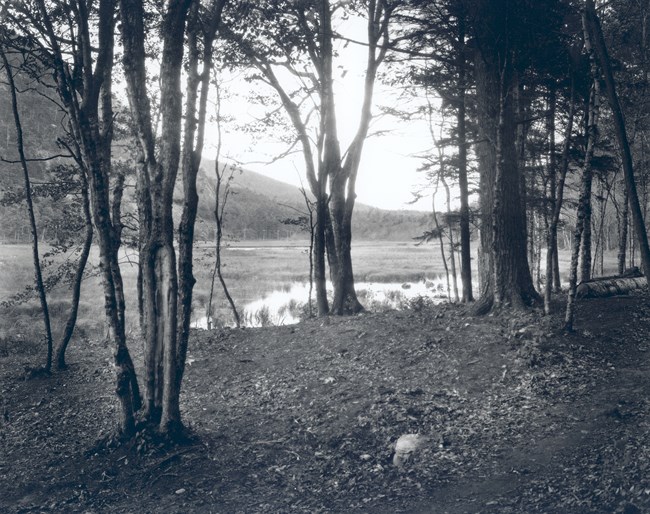
Courtesy National Park Service/Acadia National Park Mount Desert Island’s present-day trail system evolved over centuries of human use and settlement of the land. From American Indians who blazed trails on hunting forays, to European settlers who connected villages and harvested forests, their activities provided transportation routes on the island long before the first roads were built. Rusticators and HikingIn the mid-1800s, rusticators came to the island to enjoy its beauty and to escape the bustle of large cities. They followed many of the existing paths and trails up mountains, through woods, and along ocean shoreline. Among the rusticators were Hudson River School artists Thomas Cole and Frederic Church. Their renderings of the island attracted city dwellers to experience the Maine coast. Many of those who traveled to the island were very wealthy. They built 80- and 100-room “cottages” in which to pass their summers. Some cottagers socialized at tennis matches, lawn parties, and horse shows. Others, like the rusticators before them, were lured by the natural beauty of the island and preferred hiking. By the end of the 1800s, an era of active trail building had begun. Trails lost their utilitarian origins and were transformed into paths that promoted interaction with, and enjoyment of, the natural landscape. Building Memorial PathsIn 1891, the first extensive trail plans were drafted. Much of the trail building was sponsored by village improvement societies. An innovative approach to funding construction was the creation of memorial paths. Individuals who financed a trail could name it after the person of their choice. Kurt Diederich’s Climb, which ascends Dorr Mountain’s east face, is an example of a memorial path. Plaques were often set along the trails in memory of the person who was being honored. 
NPS Photo/Kat Connelly Others who followed Waldron Bates carried on his legacy of innovation and craftsmanship. Rudolph Brunnow built the Precipice Trail over the formerly impassable cliffs of Champlain Mountain, and George Dorr, one of Acadia’s founders and the park’s first superintendent, promoted memorial paths. He oversaw the construction of several stairway trails leading from Sieur de Monts Spring to the summit of the mountain that now bears his name. From 1913 to 1916, six memorial and other approach trails would be built in the spring area by Dorr in conjunction with the Bar Harbor Village Improvement Association. He hoped this beautiful system of connector trails would bolster the case for the proposed national monument. He would include photographs in the documents they submitted to President Woodrow Wilson to convince him to agree on the national monument designation. Shift to Motor RoadsBy 1915 more than 200 miles of trails existed on the island. That same year, the state of Maine lifted the island’s ban on automobiles. By 1920 the major trail building era had ended, while an interest in building motor roads intensified. In 1929 the Seal Harbor Village Improvement Society recorded that “…an inevitable first effect of the oncoming of the automobile was the banishment of the horse and the desertion of foot paths and trails.” 
Courtesy National Park Service/Acadia National Park CCC and Trail ConstructionThe Great Depression, however, brought the New Deal and the Civilian Conservation Corps (CCC) to Acadia National Park. Two camps were established on the island in 1933, one on McFarland Hill (now park headquarters), and the other just south of Long Pond on the west side of the island. A good deal of their work involved trails. East-side crews primarily rehabilitated existing trails constructed by village improvement societies. West-side crews expanded the trail system on newly acquired tracts along the western mountains. The Perpendicular and Great Pond Trails are examples of work completed by the CCC. Today, hikers can follow the footsteps of early settlers, American Indians, and outdoors enthusiasts of another era. Acadia’s historic trails are still as challenging to present-day hikers as to those of generations past, and their scenic values and ties to the landscape evoke the same sense of awe experienced long ago. Hike Historic TrailsAt Sieur de Monts, there are six memorial paths: Emery Path, Homans Path, Schiff Path, Beachcroft Path, Kurt Diederich's Climb, Jesup Path, and Kane Path. More About Acadia's Historic Trails |
Last updated: April 11, 2025
